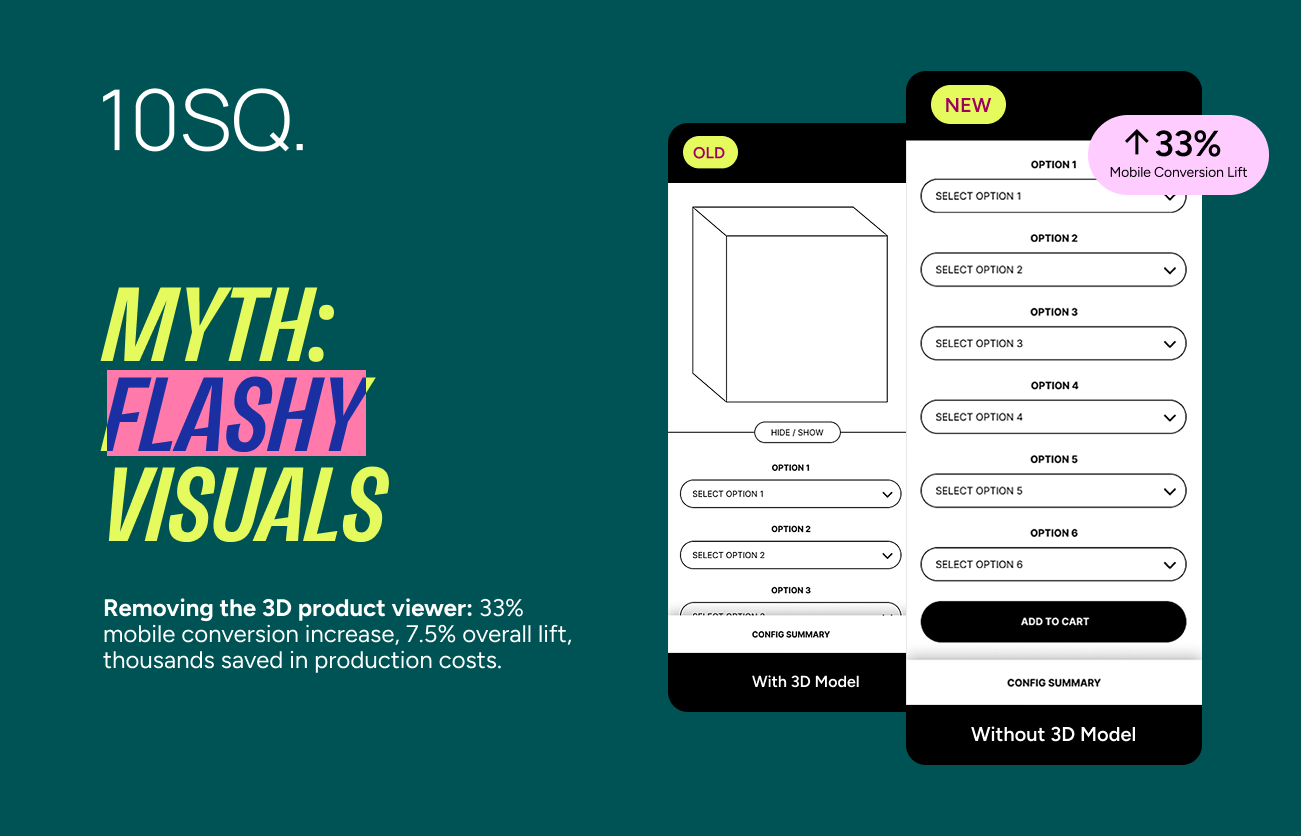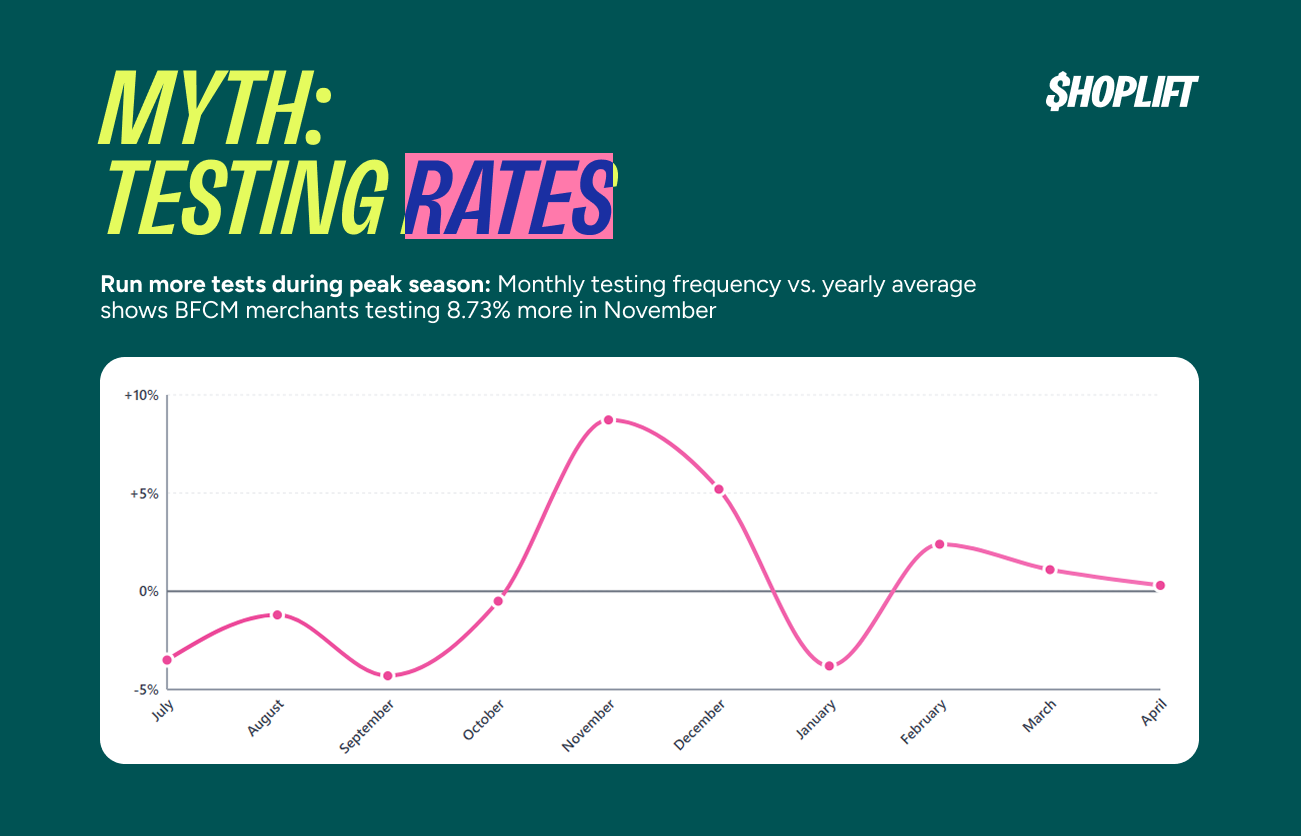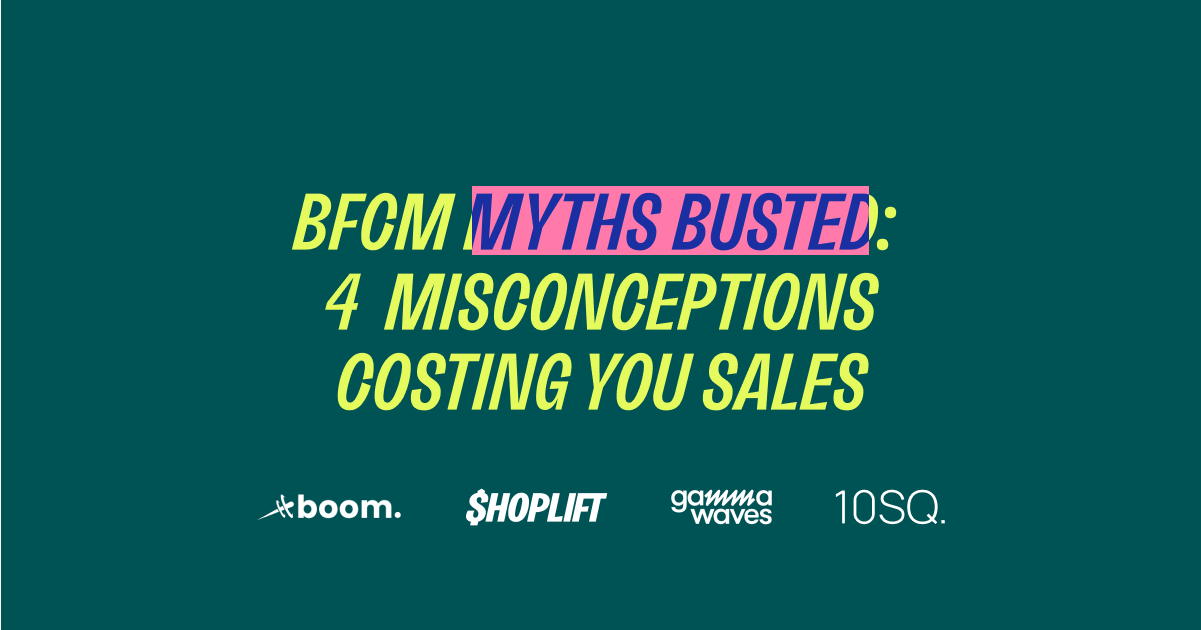BFCM Myths Busted: 4 Common Misconceptions That Are Costing You Sales
TL;DR: Most BFCM advice is recycled mythology that hasn't been tested in years. Smart merchants question everything, test their assumptions, and build strategies based on their actual customer data rather than industry folklore. The merchants who consistently outperform during Black Friday and Cyber Monday are the ones who've learned to separate fact from fiction.
Why Smart BFCM Merchants Question Everything They Hear
Every October, the same predictable cycle begins. Marketing blogs dust off last year's BFCM articles, add a fresh date, and republish the same tired "best practices" that have been circulating since 2018. Industry experts share screenshots of strategies that worked for one brand, one time, and suddenly it becomes a universal gospel.
But here's what the data actually shows: the merchants excelling during BFCM aren't the ones following conventional wisdom. They're the ones testing it.
The most successful e-commerce brands treat every piece of BFCM advice the same way a scientist treats a hypothesis. They don't assume it's true just because everyone says it. They test it with their actual customers, measure the results, and build their strategy on evidence rather than assumptions.
The Stakes: What Data Reveals About Myth-Driven vs. Evidence-Driven Results
Let's talk numbers. Merchants who base their BFCM strategy on generic industry advice typically see results that mirror industry averages. Nothing spectacular, nothing game-changing. Just... average.
Meanwhile, merchants who take a testing-first approach consistently outperform those benchmarks by 15-30%. They're not just participating in Black Friday and Cyber Monday, they're dominating it.
The cost of assumptions becomes crystal clear when you realize that during the most competitive sales period of the year, everyone following the same playbook creates a sea of sameness. Your customers can't tell you apart from your competitors because you're all doing exactly what the "experts" told you to do.
But when everyone else goes one way, the data-driven merchants go the other. They've tested what actually works for their specific audience instead of assuming generic advice applies to their unique customer base.
Your Myth-Detection System: How to Evaluate Any BFCM Advice
Before we dive into the specific myths that are costing merchants millions, let's establish a framework for evaluating any BFCM advice you encounter.
Ask yourself these three critical questions about every strategy recommendation:
"Says who?" Who is making this claim? Are they sharing their own tested results, or are they repeating what they heard from someone else? There's a massive difference between a merchant who tested something with their own customers and an "expert" who's recycling advice they read in another blog post.
"Based on what data?" Generic statements like "customers love urgency" or "mobile users prefer simple checkout" sound authoritative, but they're meaningless without context. What sample size? Which industry? What time period? If there's no data backing the claim, it's just opinion dressed up as fact.
"Tested where?" Even legitimate data can be misleading if it doesn't apply to your situation. A strategy that works for a luxury brand might fail spectacularly for a discount retailer. Results from 2019 might not hold true in 2024. Always ask whether the testing conditions match your business context.
Here are the red flags that signal myth-based advice: one-size-fits-all claims ("all customers respond to countdown timers"), no supporting data ("studies show" without citing actual studies), and advice that hasn't evolved in years (the same exact tips appearing in articles from 2020, 2021, 2022, and beyond).
Myth 1: Deep Discounting on One-Time Purchases is the Only Way to Acquire BFCM Customers
The Myth: To hit year-end acquisition targets during BFCM, you need to offer steep discounts on one-time purchases. It's the "last chance" to bring in new customers before the year ends, so you have to make the offer irresistible with your deepest price cuts.
Why This Myth Persists: BFCM represents a final opportunity for companies to hit revenue or customer acquisition targets for the year. When you're staring at a gap in your annual goals, a deep discount feels like the fastest way to flood in new customers and revenue. The logic seems sound: lower the barrier to entry as much as possible to maximize volume.
But here's the problem this approach creates: you're training customers to wait for discount periods to buy, which crushes customer lifetime value, inflates your LTV/CAC ratios, and ultimately undermines profitability and growth. This pattern is especially pronounced in supplements, beauty, health and wellness, food and beverage, and pet products. Big BFCM discounts lead to a sales collapse in the months following as customers stockpile products. The damage is compounded when discounts aren't limited in quantity or connected to longer-term offers like subscriptions.
What Actually Happened: Our partner Boom Labs, a subscription and retention optimization platform for Shopify brands, provided us with compelling data that challenges this myth directly. Working with a leading beauty supplement brand, Boom Labs helped shift the entire BFCM strategy away from deep one-time discounts. Instead of the traditional approach, they focused on acquiring customers through subscription or trial offers during BFCM, then followed up with personalized upsell offers for different products or bundles during the New Year period.
The results were dramatic. The subsequent year after implementing this approach saw record recurring revenue and active subscriber growth in Q1 as customers stayed on from their BFCM subscription offers. This "1-2 punch" strategy, acquiring customers on subscription during BFCM and then delivering targeted upsells during New Year promotions, produced a 100% increase in 12-month customer lifetime value for BFCM-acquired customers. Essentially, they cut their CAC/LTV ratio in half.

For context, this brand generates over $20M annually in e-commerce revenue with roughly 100,000 monthly site visitors. The BFCM offers extended through the New Year period, creating a cohesive acquisition and retention strategy rather than a one-off sales event.
The Truth: Shape your BFCM offer around lifetime value, not one-time transactions. This approach will be merchant-specific, but the principle holds across categories: the goal isn't just to acquire customers during BFCM, it's to acquire the right customers in the right way. A slightly smaller discount that onboards customers into a subscription or creates a foundation for future purchases will dramatically outperform a steep one-time discount that trains customers to only buy when you're practically giving products away. Think beyond the weekend and design offers that set up profitable customer relationships, not just quick hits to your revenue dashboard.
Myth 2: Adding More Features Always Improves the Customer Experience
The Myth: Advanced features like 3D product viewers and interactive configurators automatically enhance the shopping experience and boost conversions. More functionality equals better results.
Why This Myth Persists: Flashy, high-tech features promise novelty and differentiation. A 3D product viewer feels like innovation and progress. Refining existing experiences seems less exciting, even though it's often what actually drives conversions.

What Actually Happened: Our partner 10SQ shared a compelling test from one of their clients, a home decor brand selling customizable furniture. The brand had invested significantly in 3D visualization technology. Using Shoplift, 10SQ and their client tested removing the 3D model entirely on mobile while expanding the configuration area to give customers more space for selecting options.
The results revealed a critical insight about feature value versus fundamental usability. On mobile, removing the 3D model produced a 33% increase in conversions. Shoppers on smaller screens prioritized having space to configure their options over spinning a 3D model. On desktop, conversions decreased by 5%, showing that users with more screen real estate did value the visual confirmation. The net result: a 7.5% overall conversion increase.
Beyond conversions, this finding had massive operational implications. The business had been investing significant resources creating and maintaining 3D models for every product variant, costs that weren't justified for their primary mobile audience.
Our friends at Cobra/Puma Golf found very similar results. Read about how they saved tens of thousands of dollars by testing flashy site features here.
The Truth: Focus on the fundamental core experience first. During BFCM, when traffic surges and every conversion matters, each element on your page should earn its place by actively supporting the purchase decision. The "innovative" feature you're proud of might be creating friction. Test your assumptions about what features actually matter, because that advanced functionality might be standing between your customers and checkout.
Myth 3: Luxury Brands Should Never Discount During BFCM—It Cheapens the Brand
The Myth: Luxury brands must avoid Black Friday and Cyber Monday entirely. Any discount erodes exclusivity and trains customers to wait for sales instead of paying full price.
Why This Myth Persists: BFCM is associated with big box stores and BOGO offers—everything luxury brands avoid. The logic seems sound: if luxury is built on perceived value, cutting prices reduces that perception. But modern luxury consumers aren't allergic to deals, they're allergic to badly executed ones that feel desperate or off-brand.
What Actually Happened: Our friends at Gamma Waves provided us with data from one of their clients, a quiet luxury fashion brand (think Meghan Markle and Oprah's favorite), that ran a tightly controlled Cyber Monday promotion for BFCM 2024: 30% off a curated collection for 24 hours using code VIPMONDAY24, focused exclusively on digital channels and owned customer lists.
The results flipped the myth completely. Cyber Monday generated ~$475,000, outperforming Black Friday by 8.5% despite 12% fewer orders. Average order value jumped 20% to $520. The promotional code accounted for 65% of daily revenue with more than 700 redemptions.
The long-term retention sealed it: 37% of VIPMONDAY24 customers returned for repeat purchases, many buying multiple times from full-price collections in 2025. Some became high-value loyalists with 5-7 subsequent orders. One customer placed 29 post-sale purchases. The return rate remained at 3.08%, consistent with full-price periods, proving these weren't deal-seekers but brand-seekers.

The Truth: Luxury brands can discount during BFCM when the promotion feels intentional, elegant, and brand-right. Keep promotions short (24-48 hours). Use on-brand campaign codes, not generic "SALE30" codes. Focus on digital storytelling and styling. Treat it like a private event, not a clearance moment. The mistake isn't participating in BFCM, it's participating in a way that contradicts your brand identity. When executed with brand consistency, strategic BFCM promotions can introduce high-value customers who become full-price loyalists.
Subscribe to the Shoplift newsletter
Get insights like these emailed to you bi-weekly!
{{hubspot-form}}
Myth 4: Testing During Peak Traffic Periods Is Too Dangerous
The Myth: Black Friday and Cyber Monday are too critical to experiment. When you're facing the highest-stakes shopping period of the year, stick with what you know and save testing for slower periods.
Why This Myth Persists: BFCM represents 20-30% of annual revenue for many merchants. One wrong move could cost hundreds of thousands in lost sales. Why gamble with A/B tests when the margin for error is this slim? This thinking explains why 17.9% fewer brands test during November and December compared to the rest of the year. When pressure is on, merchants retreat to safe ground.
What Actually Happened: Analysis of testing data across the Shoplift platform revealed that merchants who test during BFCM aren't taking on additional risk. They're capitalizing on asymmetric upside that conservative competitors miss entirely.
Brands testing during November and December are 18% more likely to identify statistical winners compared to other months. While 20% of testing brands see statistically significant winners during January through September, that number jumps to nearly 25% during BFCM.

The reason? Higher traffic volume means faster time to statistical significance. Tests that take weeks to conclude in March reach significance in days during November. You're learning and optimizing at experimentation velocity that's impossible during normal periods.
The brands that recognize this opportunity test more aggressively. Testing frequency in November runs 8.73% higher than the yearly average. These merchants understand that peak traffic isn't a constraint on testing, it's an accelerant.

The Truth: BFCM is actually the best time to test if you have confidence in your testing infrastructure. Increased traffic lets you validate hypotheses faster, implement winning variations in real-time, and capture incremental revenue that cautious competitors leave on the table. The key is having a testing platform purpose-built for Shopify that can handle peak traffic without performance issues.
While 17.9% fewer brands test during the year's most critical period, the ones who do consistently see more impactful results and capture optimization opportunities that only exist at peak traffic. That's asymmetric upside: lower competition for insights, higher volume for faster learning, and the ability to compound small improvements into significant revenue gains during the period that matters most.
Building Your Testing-First BFCM Strategy: The Competitive Advantage
Now that we've busted the most dangerous BFCM myths, let's talk about building a strategy based on what actually works for your business.
The testing-first approach isn't just about avoiding bad advice. It's about discovering optimization opportunities your competitors will never find because they're too busy following the crowd.
Start by identifying your biggest assumptions about BFCM customer behavior. Maybe you assume your customers want the deepest discounts possible. Or that they prefer email over SMS for promotions. Or that they'll abandon their carts if shipping isn't free. These assumptions feel obvious, but obvious doesn't mean correct.
The most successful BFCM strategies are built on actual customer behavior data, not industry assumptions. This means testing your promotional messaging, discount structures, email sequences, and checkout flows with your real audience before the season hits.
Here's the timeline that separates winners from followers: start testing your BFCM assumptions in September, optimize based on results in October, and execute a data-proven strategy during the actual sales period. While your competitors are crossing their fingers and hoping generic advice works, you'll be implementing tactics you know convert your specific customers.
The competitive advantage isn't just better results during BFCM. It's the confidence that comes from knowing your strategy is built on evidence rather than hope.
Your Next Move: Assessment and Optimization Pathway
The difference between merchants who thrive during BFCM and those who just survive comes down to preparation. Not the kind of preparation that involves copying what worked for other brands, but the preparation that involves understanding what works for your customers.
Start with a conversion audit to identify your biggest optimization opportunities before BFCM pressure hits. Look at your current customer journey through the lens of peak traffic scenarios. Where do people drop off? What creates friction? Which messages actually drive action versus which ones just sound good in theory?
The smart merchant's approach is simple: test your assumptions now, dominate during the season.
This isn't about perfecting every detail, it's about knowing which levers actually move the needle for your business. When you understand what drives conversions for your specific audience, you can double down on what works instead of spreading your efforts across generic tactics that may or may not apply to your situation.
Ready to build a BFCM strategy based on data rather than mythology? The merchants who start testing their assumptions now will be the ones celebrating record-breaking results in November. Request a free demo to begin your BFCM prep with Shoplift.
Frequently Asked Questions
Q: How do I know which BFCM "best practices" to trust and which to test?
A: Apply the three-question framework: "Says who?" (are they sharing tested results or recycled advice?), "Based on what data?" (specific numbers or vague claims?), and "Tested where?" (does the context match your business?). If advice lacks data, hasn't evolved in years, or makes one-size-fits-all claims, treat it as a hypothesis to test rather than gospel to follow.
Q: Isn't it risky to start testing BFCM strategies for the first time this year?
A: The real risk is assuming generic advice works for your specific customers without validation. Start testing your biggest assumptions in September, optimize based on results in October, and execute a data-proven strategy during BFCM. The brands that consistently outperform during peak periods are the ones who've tested their way to a strategy rather than copied someone else's playbook.
Q: What if I don't have enough traffic to get statistically significant test results?
A: BFCM actually solves this problem. The surge in traffic during November and December means tests reach statistical significance much faster than during normal periods. Tests that might take weeks to conclude in March can reach significance in days during BFCM, making it the ideal time to validate your assumptions.
Q: Should luxury or premium brands really discount during BFCM, or does that apply only to mass-market brands?
A: The question isn't whether to discount, but how to do it in a way that aligns with your brand. Keep promotions short and intentional, use on-brand campaign codes, focus on curated selections, and treat it like a private event rather than a clearance sale. When executed with the same brand consistency that defines everything else you do, strategic BFCM promotions can attract high-value customers who become full-price loyalists.
Q: How do I balance testing new approaches with executing my core BFCM strategy?
A: Testing isn't about replacing your entire strategy—it's about optimizing specific elements within it. Start by identifying your biggest assumptions about customer behavior, then test those systematically. Even small improvements compound significantly during high-traffic periods, so you don't need to test everything at once to see meaningful revenue impact.





